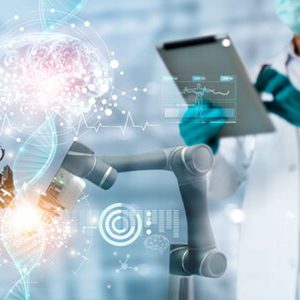Machine Learning applications: an opportunity to personalize healthcare
Self-driving cars, Siri and space-exploring robots. All forms of machine learning artificial intelligence (‘AI’) driving the tech revolution. By analysing vast amounts of data and identifying patterns and relationships, machine learning can make predictions based on new data and behaviour analysis. The raw power of this technology combined with human ingenuity presents limitless opportunities for advancement, and perhaps its greatest feat will be in the field of healthcare.
Combine a lack of investment, a deadly pandemic and an ageing population and what do you get? A crumbling healthcare system. Machine learning AI and its potential to revolutionize medicine may be one of the last rays of hope for drained healthcare systems across the world. So how can it fix our broken systems?
First things first, get rid of the paperwork. Studies have shown that doctors spend an average of 16 minutes on the computer for each patient.[1] There is no denying that technological advancements such as taking patient records through voice recognition technology would save hours of precious time. Thus, increasing efficiency and allowing the doctor to place a greater focus on the patient.
Patients monitored through AI-connected sensors could make overcrowded hospitals a relic of the past. Rather than being kept in wards, patients can be monitored from the comfort of their homes and any changes in the patient’s condition is picked up by sensors that alerts the relevant health services. This consequently reduces the costs involved with healthcare, particularly in the US where the average hospital stay overnight cost $14,900 in 2020.[2] Not to mention saving human resources and reducing any health risks posed by the hospital environment.
But it doesn’t stop there. Our body has the potential to generate a lot of data. Through wearable devices, smartwatches and even our smartphones we create digital biomarkers. Machine learning models, such as alertR, process this data using behavioural intelligence to detect changes in health patterns and give personalized health suggestions. The potential for this technology to monitor chronic conditions such as diabetes could improve a patient’s quality of life and lifespan. Furthermore, visiting a health professional due to changes picked up by sensors is much more effective than regular check-ups or waiting for the individual to spot a problem with their own condition.
 Machine learning could also pave the way to a new kind of medicine: Personalized Medicine. By evaluating the genetic information, environmental and lifestyle factors and medical history of a patient, it is possible to tailor a treatment and intervention to the specific needs of a patient. Gone would be the days of general treatments for the population, replaced with a system that is fine-tuned to each individual body’s specific needs and makeup.
Machine learning could also pave the way to a new kind of medicine: Personalized Medicine. By evaluating the genetic information, environmental and lifestyle factors and medical history of a patient, it is possible to tailor a treatment and intervention to the specific needs of a patient. Gone would be the days of general treatments for the population, replaced with a system that is fine-tuned to each individual body’s specific needs and makeup.
Machine learning models even go as far as taking over some of the diagnostic functions of doctors through image scanning (x-rays, retinal scans etc.). One AI programme trained in retinal scanning is able to differentiate gender through retinal scans, something which no human doctor can do.[3]
With all these amazing applications you might be wondering, what is the catch? Data. All of the applications mentioned above require access to data. Access to data is monitored by privacy laws. No area of the law is more protective of privacy than healthcare. For good reason, malicious use of this data could be catastrophic. Just imagine, for example, how a life insurance company might use high-level predictions of a patient’s future health.
If our healthcare systems are to survive, urgent actions are needed. Governments continue to use data collection solely to treat patients in the now, but should begin to look forward to how patient data can improve predictions and treatments in the future. Founder and CEO of smartR AI, Oliver King-Smith, stresses the importance of working with governments to protect patient data and utilize it in the most efficient ways possible. Could generative AI and its creation of synthetic data be the answer to all our privacy problems? There is a future for technology and healthcare to work hand in hand, but we must begin to address these issues now. The tech revolution waits for no one.
Citations:
[1] Rapaport, L. (2020) Doctors average 16 minutes on the computer for every patient, Reuters. Thomson Reuters. Available at: https://www.reuters.com/article/us-health-ehr-idUSKBN1ZC2GY (Accessed: February 17, 2023).
[2] Charaba, C. (2023) How much does a hospital stay cost? PeopleKeep, Inc. Available at: https://www.peoplekeep.com/blog/infographic-how-much-does-a-hospital-stay-cost#:~:text=According%20to%20the%20most%20recent,a%20hospital%20stay%20was%20%246%2C326 . (Accessed: February 17, 2023).
[3] Korot, E., Pontikos, N., Liu, X. et al. Predicting sex from retinal fundus photographs using automated deep learning. Sci Rep 11, 10286 (2021). https://doi.org/10.1038/s41598-021-89743-x
Written by Celene Sandiford, smartR AI
